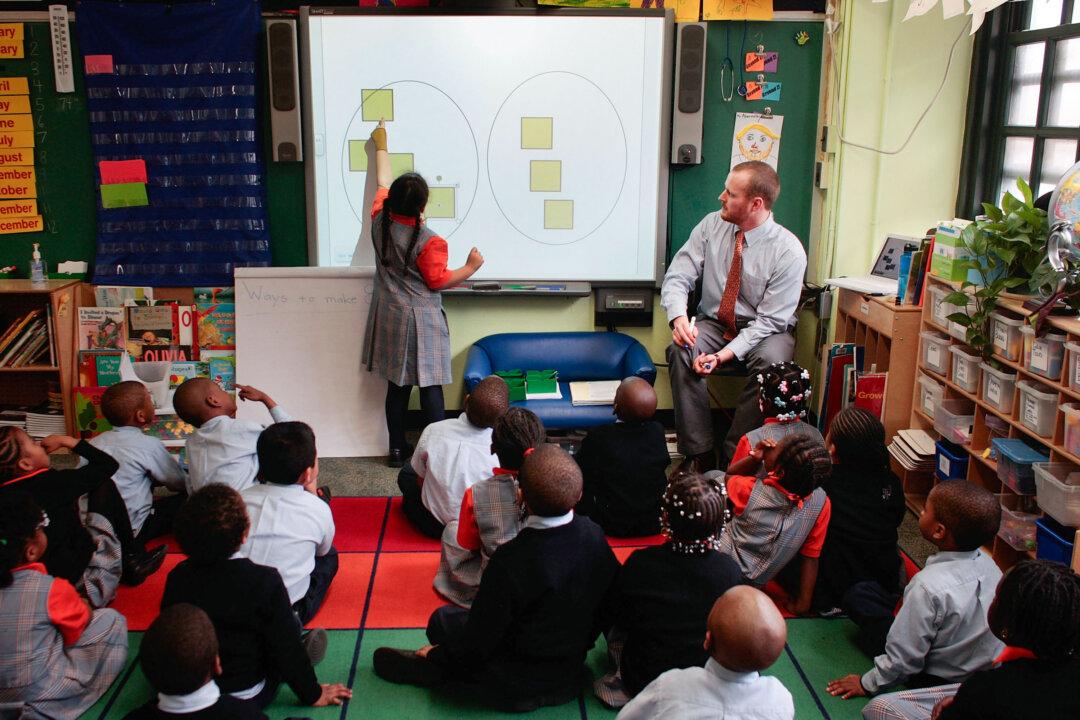New research indicates that U.S. public school spending has doubled since 2003, outpacing the rate of inflation and showing no clear correlation between more dollars per pupil and higher eighth-grade math and fourth-grade reading scores.
The Edunomics Lab at Georgetown University released its latest findings last month. The report, titled “Will Academic Recovery Stall When the Federal Relief Funds Dry Up?” also draws attention to the fiscal cliff many districts face in the year ahead as they weigh expenditures against desired achievement.
School districts are required to earmark whatever is left of their post-COVID American Rescue Plan Elementary and Secondary School Emergency Relief (ESSER) funds by Sept. 30. The liquidation deadline is Dec. 31. ESSER, established in 2021, allocated $122 billion over three phases to help schools with learning recovery efforts.
Most of the ESSER money was spent on labor—more teachers, classroom aids, counselors, reading coaches, tutors, subject area specialists, and administrators, but it was not applied to raise pay rates for existing teachers, Edunomics Lab Director Marguerite Roza told The Epoch Times on July 10.
While one device (laptop or tablet) per child became an industry standard largely funded by federal money, equipment purchases did not make up a significant portion of expenditures, Ms. Roza said. She and her team of researchers interviewed school administrators and analyzed data at the federal and state levels dating back 20 years, including information from the National Assessment of Educational Progress, which runs The Nation’s Report Card website. Many comparisons cited involved shorter time frames, and the findings were largely focused on the pandemic era.
“The priorities and the value these investments brought varied by state,” Ms. Roza told The Epoch Times on July 10. “Some states were able to eke out more value.”
At the national level, math scores declined sharply between 2013 and 2022, with 30 states reporting that students were more than half of a grade level behind before scores began rising slightly between 2022 and 2023, according to the report.
For reading, the negative trend line began in 2017, with the average score in 30 states dropping below grade level in 2020 and continuing downward until last year, the report noted.
Meanwhile, the national average per-pupil spending rate increased by 100 percent between 2003 and 2023 to $16,100 ($1,350 of the 2023 amount came from federal relief funds). Total inflation for the two decades was 67 percent, according to the report.
The report also notes that U.S. schools now have more instructional staff than ever before, with that number increasing from 3,465,906 in 2005 to 3,842,000 this past academic year ending in the spring of 2024. By contrast, the number of K-12 public school students during the same period increased slightly, from 48,150,528 to 49,033,092.
Ms. Roza stressed that results were varied at the state level. Mississippi, Illinois, Ohio, and Kentucky reported reading/English Language Arts assessment scores averaging above grade levels during the 2022-2023 academic year, while average scores in California, Oregon, Washington State, Virginia, and South Dakota were below grade level.
Mississippi’s overall per-pupil spending rate has been much lower than that of the schools it outperformed, but its ESSER aid per student, at about $1,600 compared to California’s estimated $1,300, is higher. The report also noted that the Golden State disproportionately spent more money on social-emotional learning, tutoring, and summer programs.
“But,” Ms. Roza said, “within the states, some individual districts saw some real growth, and some saw lackluster growth. Compton (California) saw quite impressive scores.”
For math assessments, all states surveyed reported average scores around or above grade level in the 2022-2023 school year, with Tennessee, Pennsylvania, and Mississippi showing the most progress, with average scores approaching or exceeding half of the next grade level, according to the report.
In the absenteeism measurements section, the report shows that attendance improved in most states between 2022 and 2023, highlighted by Hawaii and Michigan’s 7 percent increases. South Carolina reported a 5 percent decrease, and Louisiana reported a 4 percent decrease.
“Is it possible to get improved outcomes without sizable funding increases? Yes. There are policy strategies that wouldn’t require new funds,” Ms. Roza said. “What really matters is implementation.”
She said this research is a work in progress. The 2024 national and state reading and math assessment scores should be available by October, and final ESSER expenditure figures by school district and state should be available next month.
The U.S. Department of Education notes that while learning recovery in the wake of the pandemic is the highest priority of ESSER, the program also aims to rebuild the educator workforce and help schools operate safely. With the ESSER program ending, many school districts must find other ways to cover those added labor costs, either by increasing the tax levy, making cuts in different areas of the budget, or obtaining more state aid.
In the Guymon Public School District in the Oklahoma panhandle, about $7 million in ESSER funds were applied to replace the high school’s heating, cooling, ventilation, and air conditioning system, which was considered a facility safety issue. Superintendent Dixie Purdy said the district did not come to rely on aid for other programs and is financially sound heading into future school years.







